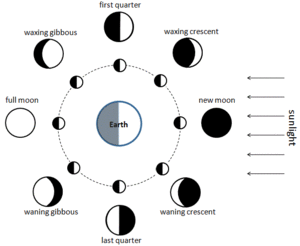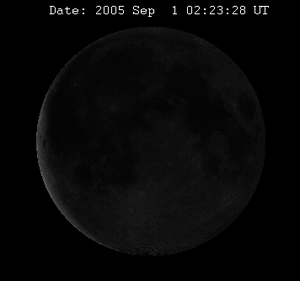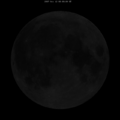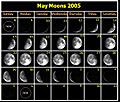Phases of the Moon facts for kids
The phases of the Moon are the different shapes the Moon seems to have when we look at it from Earth. The Moon itself doesn't actually change shape! It just looks different because of how much of its surface is lit up by the Sun as it moves around Earth.
Imagine the Moon is like a ball. Half of this ball is always lit by the Sun. As the Moon orbits Earth, we see different amounts of that lit-up half. When the Moon appears to be getting bigger, it's called waxing. When it looks like it's getting smaller, it's called waning. Each set of phases takes about 29.5 days to complete, which is roughly a month.
Because of something called tidal locking, the same side of the Moon always faces Earth. This means the phases we see always happen on the same half of the Moon's surface.
Contents
The Moon's Changing Looks
The Moon goes through 8 main phases. Let's explore them!
- A new moon is when you can't see the Moon at all. This happens because the Moon is directly between the Earth and the Sun, so we are looking at the side that isn't lit up. A solar eclipse can only happen during a new moon.
- A waxing crescent moon is when the Moon looks like a thin crescent shape. This crescent gets bigger each day. You can usually see this phase in the western sky after sunset.
- The first quarter moon (sometimes called a half moon) is when you can see exactly half of the Moon's lit-up side. This phase happens about a week after the new moon.
- A waxing gibbous moon is when more than half of the Moon is lit up, and the lit part continues to grow bigger each day. This phase occurs between the first quarter and the full moon.
- A Full Moon is when we can see the entire lit-up half of the Moon. This happens when the Moon is on the opposite side of the Earth from the Sun. A lunar eclipse can only happen during a full moon.
- A waning gibbous moon is when more than half of the Moon is still lit, but the lit part starts to shrink each day. This phase happens between the full moon and the last quarter moon.
- The last quarter moon (also called a half moon) is when you can see half of the Moon's lit-up side again, but it's the opposite half from the first quarter.
- A waning crescent moon is when the Moon looks like a thin crescent again, but this time it's getting smaller each day. This is the last phase before the new moon, and then the cycle starts all over again!
What is a "Blue Moon"?
Sometimes, you might hear about a "blue moon." This is usually when there are two full moons in the same calendar month. This doesn't happen very often, only about every three years. The saying "Once in a blue moon" means something that happens very rarely.
Super Pink Moon
A supermoon happens when the Moon is closest to Earth in its orbit. When a full moon happens at this time, it's called a supermoon. Supermoons usually happen between March and May each year. Because the Moon is so close, a supermoon can look up to 7% larger and 15% brighter than a regular full moon!
The name "Pink Moon" comes from an old tradition. Any full moon in April was called a pink moon because it was when a pink wildflower, called moss pink, started to bloom.
Cool Facts About the Moon's Phases
- The Moon is Earth's only natural satellite.
- The Moon's surface is actually quite dark. The bright parts we see from Earth are just sunlight reflecting off it.
- The Moon is about 400 times smaller than the Sun, but it's also about 400 times closer to Earth. This is why they can look similar in size in the sky!
- The Moon's gravity causes the tides in the ocean.
- Gravity on the Moon is much weaker than on Earth. If you weigh 100 pounds on Earth, you'd only weigh about 16.6 pounds on the Moon!
- A lunar eclipse happens when the Earth passes directly between the Sun and the Moon. This casts a shadow on the Moon, making it look dark or reddish.
- A solar eclipse happens when the Moon passes directly between the Sun and the Earth. This casts a shadow on Earth, making the Sun appear to disappear for a short time.
- If you were on the Moon, you would see the Earth go through phases too! When it's a new moon for us on Earth, it would be a full Earth for someone on the Moon.
Related pages
Images for kids
-
A full Moon sets behind San Gorgonio Mountain in California.
-
The phases of the Moon as seen from the Northern Hemisphere.
-
A crescent Moon over Kingman, Arizona.
See also
 In Spanish: Fase lunar para niños
In Spanish: Fase lunar para niños








